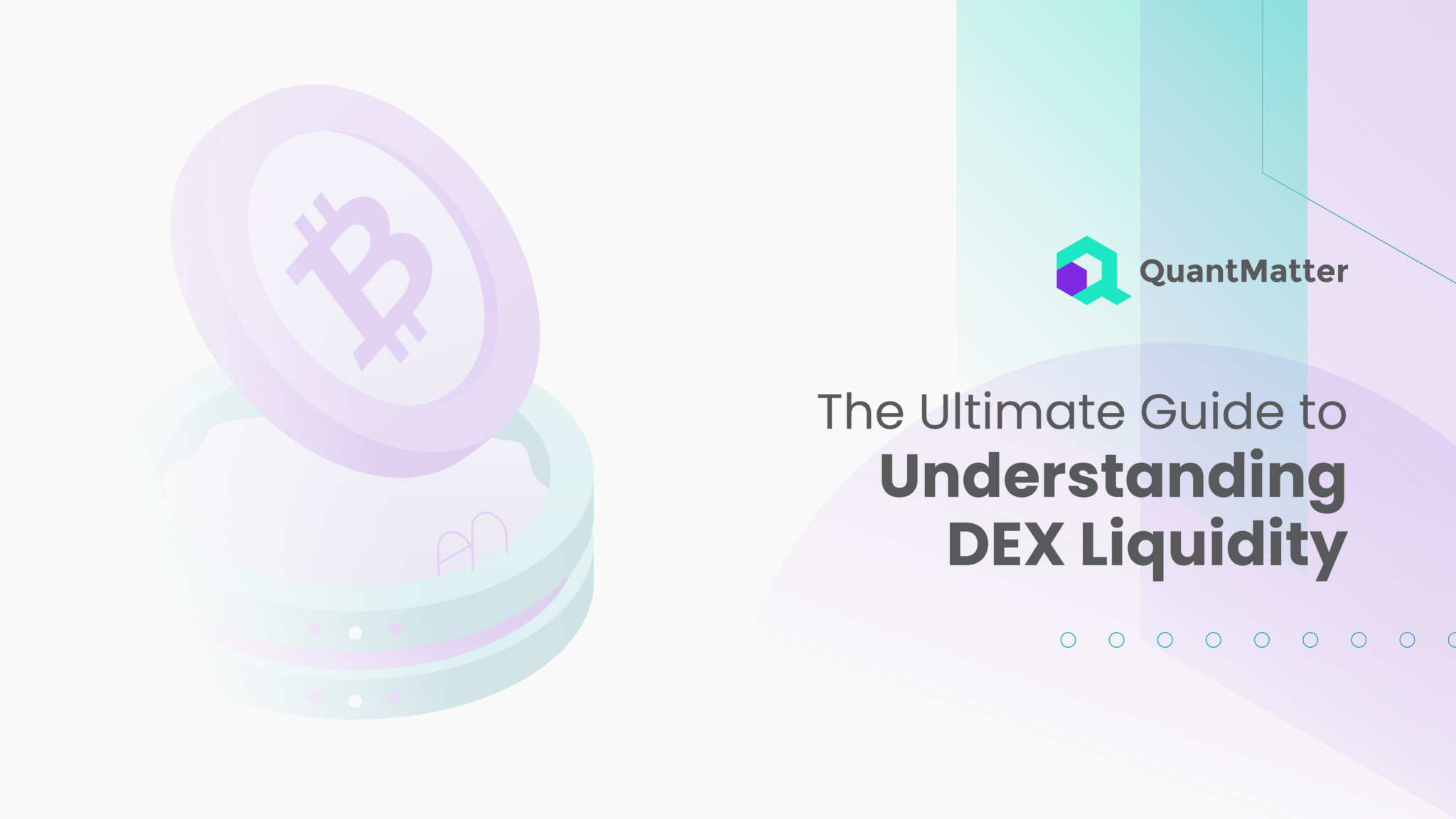
This guide aims to provide a comprehensive understanding of DEX liquidity. We will explore its importance, how it works, the factors that influence it, and what you can do to assess and improve liquidity on decentralized exchanges.
In the world of decentralized finance (DeFi), decentralized exchanges (DEXs) play a crucial role in facilitating peer-to-peer trading of cryptocurrencies. Unlike centralized exchanges, DEXs operate without intermediaries, allowing users to trade directly from their wallets. However, one key aspect that significantly affects the efficiency and usability of these platforms is liquidity.
Liquidity, in simple terms, refers to how easily an asset can be bought or sold without affecting its price. In the context of DEXs, liquidity determines how smooth and fast transactions can be executed. High liquidity ensures that there is enough volume for traders to enter and exit positions with minimal slippage, while low liquidity can lead to higher costs and less efficient trading.
What is DEX Liquidity?

DEX liquidity refers to the availability of assets for trading on a decentralized exchange. It is the measure of how much of an asset is available to be bought or sold at a given price. Liquidity is a critical factor in determining the efficiency of a DEX, as it affects the ease with which traders can execute transactions.
Also Read: IPO vs ICO: A Comprehensive Comparison
In a liquid market, there is a large volume of assets available, and trades can be executed quickly without causing significant price fluctuations. Conversely, in an illiquid market, there may be fewer assets available, leading to higher slippage—where the price of an asset changes between the time a trade is placed and when it is executed.
Liquidity in DEXs is typically provided by liquidity pools, which are collections of funds contributed by users (liquidity providers). These pools allow the DEX to match buyers and sellers efficiently without relying on a traditional order book. The more liquidity in these pools, the better the trading experience for users.
Why is Liquidity Important in DEXs?

Liquidity is the lifeblood of any trading platform, and its importance in DEXs cannot be overstated. High liquidity ensures that traders can execute large orders with minimal impact on the market price. This is particularly important in volatile markets, where prices can change rapidly.
Reduced Slippage
One of the most significant advantages of high liquidity in decentralized exchanges is the reduction of slippage. Slippage occurs when there is a difference between the expected price of a trade and the actual price at which the trade is executed. In markets with low liquidity, even a relatively small trade can shift the price, resulting in the trader receiving a less favorable rate than anticipated.
For example, if you’re attempting to buy a large quantity of a particular cryptocurrency on a DEX with low liquidity, the lack of available sell orders at your desired price might force the system to execute part of your order at higher prices. This means you end up paying more than expected, which is the essence of slippage. However, in a highly liquid market, there are usually enough buy and sell orders available to accommodate large trades at consistent prices, thereby minimizing slippage. This is crucial for traders, especially those who deal in large volumes or engage in high-frequency trading, as it directly impacts their profitability.
Increased Trader Confidence
High liquidity doesn’t just reduce slippage; it also builds trust and confidence among traders. When traders are confident that they can easily enter and exit positions without affecting the market price, they are more likely to participate actively. This is particularly important in the world of decentralized finance, where the absence of intermediaries means that traders rely heavily on the robustness of the platform’s liquidity to ensure smooth transactions.
A liquid market is seen as a sign of health and stability. It indicates that there are enough participants actively trading, which in turn reassures other traders that they can execute their strategies without facing significant obstacles. This increased confidence often leads to higher trading volumes, which further enhances liquidity. It’s a self-reinforcing cycle: higher liquidity attracts more traders, and more traders contribute to even higher liquidity, benefiting the entire ecosystem.
Challenges of Low Liquidity
On the flip side, low liquidity can create a host of problems for both traders and the DEX itself. When liquidity is low, large trades can cause significant price movements, making it difficult to execute transactions at the desired price. This not only increases costs for traders but can also deter them from using the platform altogether. For example, if a trader needs to buy a substantial amount of a token but knows that doing so will push the price up considerably, they might seek out a different platform with better liquidity or even avoid making the trade entirely.
Additionally, low liquidity can make the market more susceptible to price manipulation. In an illiquid market, it only takes a relatively small amount of capital to influence prices, which can lead to artificial price movements and increased volatility. This can be particularly damaging for newer or smaller tokens that are more likely to suffer from low liquidity. Manipulative traders might exploit these conditions to their advantage, creating an unstable environment that can drive away genuine participants and harm the platform’s reputation.
How Does Liquidity Work in a DEX?

Understanding how liquidity works in a DEX requires a basic understanding of liquidity pools and automated market makers (AMMs). Unlike centralized exchanges that use order books to match buyers and sellers, DEXs rely on liquidity pools.
A liquidity pool is a smart contract that holds funds in a pair of tokens. For example, a DEX might have a liquidity pool for ETH/USDT. When you trade on a DEX, you are not directly trading with another person; instead, you are trading with the liquidity pool.
Liquidity providers (LPs) add funds to these pools and, in return, earn a portion of the trading fees generated by the pool. The prices of the assets in the pool are determined by an algorithm, typically a constant product formula, which ensures that the product of the two token balances remains constant.
The more funds in a liquidity pool, the better the liquidity. This is because larger pools can handle larger trades without significantly affecting the price. Conversely, smaller pools are more susceptible to price fluctuations, leading to higher slippage for traders.
Factors Affecting DEX Liquidity
Liquidity on decentralized exchanges (DEXs) is a dynamic aspect that can be influenced by several key factors. For traders and liquidity providers, understanding these factors is essential for navigating the DeFi landscape effectively. By recognizing what drives liquidity, participants can make better-informed decisions, optimize their strategies, and contribute to a healthier trading environment.
Trading Volume
One of the most direct indicators of liquidity on a DEX is trading volume. High trading volume typically signals a vibrant market with many active participants. In such markets, liquidity providers (LPs) have more opportunities to earn fees, which naturally attracts more liquidity into the system. When a DEX experiences a surge in trading activity, the increased volume helps to tighten spreads—the difference between the buy and sell prices—making it easier for traders to execute large orders without significant price changes. Conversely, low trading volume can be a red flag, indicating that trades might be harder to execute without moving the market, leading to higher slippage and less efficient trading.
Liquidity Provider Incentives
Incentives are a powerful tool for attracting liquidity providers to a DEX. Many platforms offer rewards, often in the form of native tokens or a share of the trading fees, to those who contribute to liquidity pools. These incentives can be particularly effective when new tokens or trading pairs are launched, as they provide an additional reason for LPs to support the market. By offering competitive incentives, DEXs can quickly build up liquidity, ensuring that traders have a smooth and efficient trading experience. However, these incentives need to be carefully balanced, as overly generous rewards can lead to unsustainable liquidity that might disappear when the incentives are reduced or removed.
Market Volatility
Market volatility is a double-edged sword when it comes to liquidity. On one hand, periods of high volatility can drive up trading volumes, as traders rush to capitalize on price movements. This influx of activity can temporarily boost liquidity, as more participants enter the market. On the other hand, extreme volatility can have the opposite effect, prompting liquidity providers to withdraw their funds to avoid potential losses. In such cases, the sudden drop in liquidity can exacerbate price swings, making the market even more volatile. For this reason, DEXs and LPs must carefully monitor market conditions and adjust their strategies accordingly to maintain stable liquidity levels.
Arbitrage Opportunities
Arbitrage opportunities play a crucial role in maintaining liquidity and price stability across different platforms. Arbitrageurs, who profit by exploiting price differences between exchanges, help to balance prices by buying low on one platform and selling high on another. This activity not only provides liquidity but also ensures that prices remain relatively consistent across different DEXs. When arbitrage is actively occurring, it signals a healthy, interconnected market where liquidity is more evenly distributed. Without arbitrage, price discrepancies could persist, leading to fragmented markets and reduced liquidity on some platforms.
Regulatory Environment
The regulatory environment surrounding decentralized finance can have a significant impact on liquidity. While DEXs are designed to operate without intermediaries, the actions of regulators can still influence market behavior. For instance, regulatory crackdowns on certain assets or trading practices can lead to a reduction in liquidity as traders and LPs become more cautious. This is particularly true in regions where regulatory uncertainty is high. On the flip side, clear and supportive regulations can encourage more participation in DEXs, boosting liquidity as confidence in the market grows. Therefore, keeping an eye on the evolving regulatory landscape is crucial for understanding and anticipating changes in DEX liquidity.
The liquidity of a decentralized exchange is influenced by a complex interplay of factors. Trading volume, incentives for liquidity providers, market volatility, arbitrage opportunities, and the regulatory environment all play a role in shaping the liquidity landscape. For participants in the DeFi ecosystem, staying informed about these factors is key to making sound decisions and ensuring that they can effectively navigate the ever-changing market conditions. By understanding what drives liquidity, traders and LPs can better position themselves to capitalize on opportunities and mitigate risks in the decentralized finance space.
Also Read: How Liquidity Tokens Work: An In-Depth Analysis
Tips for Improving DEX Liquidity
Improving liquidity on a DEX is a shared responsibility between the platform, liquidity providers, and traders. Here are some strategies that can help boost liquidity:
- Offering Attractive Incentives: DEXs can attract more liquidity by offering incentives such as staking rewards, liquidity mining, or profit-sharing mechanisms.
- Promoting New Token Listings: When new tokens are listed, offering enhanced rewards or reduced fees for providing liquidity can attract initial liquidity providers and traders, kickstarting the liquidity for that pair.
- Engaging the Community: Building a strong community around a DEX can drive more users to participate as traders and liquidity providers. Community engagement, education, and transparent communication are key to fostering this environment.
- Cross-Chain Liquidity Solutions: With the rise of cross-chain technology, DEXs can integrate with other blockchains to tap into larger liquidity pools. This can significantly enhance liquidity by allowing assets to be traded across different networks.
- Leveraging Automated Strategies: Automated strategies, such as using bots to provide liquidity or execute trades, can help maintain liquidity even during low-activity periods. These bots can be programmed to respond to market conditions, providing liquidity where and when it is most needed.
Conclusion
Understanding DEX liquidity is essential for anyone involved in decentralized finance. Whether you are a trader looking to execute efficient trades or a liquidity provider seeking to maximize your returns, liquidity plays a central role in your success.
High liquidity ensures smooth trading with minimal slippage and price impact, creating a better user experience. It also attracts more participants to the market, which in turn further boosts liquidity.
As the DeFi ecosystem continues to evolve, liquidity management will remain a critical factor in the growth and success of decentralized exchanges. By staying informed about how liquidity works and the factors that influence it, you can make smarter decisions and contribute to a healthier, more robust DeFi market.
In conclusion, whether you are a beginner just getting started or an experienced participant in the DeFi space, understanding and optimizing DEX liquidity is key to maximizing your opportunities and minimizing risks in this dynamic and rapidly evolving landscape.
Disclaimer: The information provided by Quant Matter in this article is intended for general informational purposes and does not reflect the company’s opinion. It is not intended as investment advice or a recommendation. Readers are strongly advised to conduct their own thorough research and consult with a qualified financial advisor before making any financial decisions.

I'm Carina, a passionate crypto trader, analyst, and enthusiast. With years of experience in the thrilling world of cryptocurrency, I have dedicated my time to understanding the complexities and trends of this ever-evolving industry.
Through my expertise, I strive to empower individuals with the knowledge and tools they need to navigate the exciting realm of digital assets. Whether you're a seasoned investor or a curious beginner, I'm here to share valuable insights, practical tips, and comprehensive analyses to help you make informed decisions in the crypto space.
- Carinahttps://quantmatter.com/author/carina/
- Carinahttps://quantmatter.com/author/carina/
- Carinahttps://quantmatter.com/author/carina/
- Carinahttps://quantmatter.com/author/carina/
